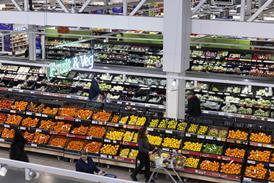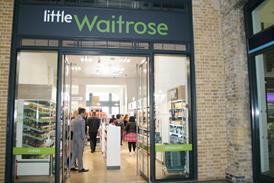Coupons, it has to be said, are not seen as cutting edge. Plastic loyalty cards, on the other hand, are seen as the highly personal panacea for busy, sophisticated shoppers.
But of course it's not that simple. It's thought that more than 48% of people have more than one grocery loyalty card while, according to the Competition Commission, only 5% of customers view loyalty cards as a particularly important service. A pertinent finding in view of Sainsbury's recent launch of its pan-retailer Nectar card.
Separately, coupons and cards are useful to an extent, but retailers are now starting to put the two together in a bid to get better results, taking the battle for loyalty from the postbox to the till.
Issuing coupons with loyalty cards at the point of purchase means both retailer and supplier can work out exactly who redeems their offers and which deals are most effective, while shoppers get the personal touch and that extra incentive to remain loyal. And, as an added bonus, printing coupons at the till is also cheaper than direct mail as the retailer then doesn't have to pay for postage.
Tesco recently started handing out coupons at tills (see box) using information from Clubcard, while Somerfield is trialling a similar scheme with Saver Card users in 30 stores. Shoppers get coupons at the till which can be used for money off products - for example, Save 50p when you spend £2.50 or more on fruit juice'. The deals are worked out personally and labelled saver bonus - exclusively for you.'
A spokesman says it is about making loyalty work harder for the chain and making better use of data."We've got an immediate communication with them, which is very particular."And he adds: "We're extremely pleased with how the Saver Card is working as it is driving sales in trial stores."
Grubby little things come of age
Nick Green, md of instore marketing specialist Catalina, reckons that people remember to use coupons in proportion to the frequency they shop - if there isn't much time between visits, there's less likelihood of coupons getting lost. "Coupons fell out of favour because if they weren't tightly targeted, shoppers wouldn't want to use them. They used to be thought of as grubby little things, but they've come of age.Tesco's move to the checkouts will send a strong signal to the marketplace."
Green says point of sale is one of the most effective places to talk to consumers. "It's extremely cost-effective because it covers 100% of your customer base. Direct mail has many benefits, but it costs a lot of money and you won't hit everybody. A kiosk looks very sexy, but it's only a sub-set of shoppers who'll bother to use it and one bad experience can put them off for good."
Tony Clarke, director at International Consumer Loyalty Programmes, agrees: "Instead of the consumer having to take the initiative and use a kiosk, it delivers offers to them in a much more dynamic way."
He says it is better for shoppers to get money-off coupons than just cash - or points - off their bill, because the latter doesn't drive incremental sales and they don't end up buying more or different things. Although manufacturers are using money-off coupons as a way of getting shoppers to spurn competitors' products, Green warns that if it's done consistently, they won't be buying more, and therefore it won't grow the category.
Somerfield isn't keen to play manufacturers off against each other because it believes it's not worth giving Coke buyers money off Pepsi in a bid to get them to change alliegances. "If they're buying Pepsi it's because they like it," says a spokesman.
Irish retailer Superquinn has had the same idea as its UK counterparts and is using its Superclub loyalty scheme to create offers tailored to shoppers.
It prints messages on till receipts to different customer groups, such as information on how close they are to saving up enough points on a promotion, or identifying and reacting to when one of the 100 best customers is in the store by giving them an extra discount. As an added bit of touchy-feely marketing, this message can be transmitted to the store manager who can even go up and greet them.
Superquinn head of IT Eric Hayes says being able to create more flexible offers, more often, is vital to maximise the marketing potential of the Superclub scheme, of which nearly 80% of customers are members.
Says Hayes: "The challenge is to keep our customers interested by designing new and relevant promotions. He adds: "We're moving closer to individual baskets, and giving people specific messages. We think it makes them more loyal."
But although till coupons are being touted as the most modern way to appeal to shoppers, Hayes believes a paperless system would be ideal.
"Rather than have the drudge of collecting a voucher, it would be better if customers could be told that they'd already been given the discount."
Catalina's Green believes that keeping up the profile is key. "Tesco found that response to its direct mail coupons wasn't that great but as they became more frequent the more the response rate went up."
And Clarke reckons loyalty is still an important way of enhancing value and offseting price competition. "Loyalty won't replace value or location - they are the key drivers - but it will enable you to understand consumers better and deliver what they want when they want it."
And KPMG's UK head of retail Amanda Aldridge warns: "It's important to keep people loyal, but people like Asda have shown you don't need a loyalty card to do that - you just have to understand their needs and give them what they want in store."
{{ANALYSIS }}
But of course it's not that simple. It's thought that more than 48% of people have more than one grocery loyalty card while, according to the Competition Commission, only 5% of customers view loyalty cards as a particularly important service. A pertinent finding in view of Sainsbury's recent launch of its pan-retailer Nectar card.
Separately, coupons and cards are useful to an extent, but retailers are now starting to put the two together in a bid to get better results, taking the battle for loyalty from the postbox to the till.
Issuing coupons with loyalty cards at the point of purchase means both retailer and supplier can work out exactly who redeems their offers and which deals are most effective, while shoppers get the personal touch and that extra incentive to remain loyal. And, as an added bonus, printing coupons at the till is also cheaper than direct mail as the retailer then doesn't have to pay for postage.
Tesco recently started handing out coupons at tills (see box) using information from Clubcard, while Somerfield is trialling a similar scheme with Saver Card users in 30 stores. Shoppers get coupons at the till which can be used for money off products - for example, Save 50p when you spend £2.50 or more on fruit juice'. The deals are worked out personally and labelled saver bonus - exclusively for you.'
A spokesman says it is about making loyalty work harder for the chain and making better use of data."We've got an immediate communication with them, which is very particular."And he adds: "We're extremely pleased with how the Saver Card is working as it is driving sales in trial stores."
Grubby little things come of age
Nick Green, md of instore marketing specialist Catalina, reckons that people remember to use coupons in proportion to the frequency they shop - if there isn't much time between visits, there's less likelihood of coupons getting lost. "Coupons fell out of favour because if they weren't tightly targeted, shoppers wouldn't want to use them. They used to be thought of as grubby little things, but they've come of age.Tesco's move to the checkouts will send a strong signal to the marketplace."
Green says point of sale is one of the most effective places to talk to consumers. "It's extremely cost-effective because it covers 100% of your customer base. Direct mail has many benefits, but it costs a lot of money and you won't hit everybody. A kiosk looks very sexy, but it's only a sub-set of shoppers who'll bother to use it and one bad experience can put them off for good."
Tony Clarke, director at International Consumer Loyalty Programmes, agrees: "Instead of the consumer having to take the initiative and use a kiosk, it delivers offers to them in a much more dynamic way."
He says it is better for shoppers to get money-off coupons than just cash - or points - off their bill, because the latter doesn't drive incremental sales and they don't end up buying more or different things. Although manufacturers are using money-off coupons as a way of getting shoppers to spurn competitors' products, Green warns that if it's done consistently, they won't be buying more, and therefore it won't grow the category.
Somerfield isn't keen to play manufacturers off against each other because it believes it's not worth giving Coke buyers money off Pepsi in a bid to get them to change alliegances. "If they're buying Pepsi it's because they like it," says a spokesman.
Irish retailer Superquinn has had the same idea as its UK counterparts and is using its Superclub loyalty scheme to create offers tailored to shoppers.
It prints messages on till receipts to different customer groups, such as information on how close they are to saving up enough points on a promotion, or identifying and reacting to when one of the 100 best customers is in the store by giving them an extra discount. As an added bit of touchy-feely marketing, this message can be transmitted to the store manager who can even go up and greet them.
Superquinn head of IT Eric Hayes says being able to create more flexible offers, more often, is vital to maximise the marketing potential of the Superclub scheme, of which nearly 80% of customers are members.
Says Hayes: "The challenge is to keep our customers interested by designing new and relevant promotions. He adds: "We're moving closer to individual baskets, and giving people specific messages. We think it makes them more loyal."
But although till coupons are being touted as the most modern way to appeal to shoppers, Hayes believes a paperless system would be ideal.
"Rather than have the drudge of collecting a voucher, it would be better if customers could be told that they'd already been given the discount."
Catalina's Green believes that keeping up the profile is key. "Tesco found that response to its direct mail coupons wasn't that great but as they became more frequent the more the response rate went up."
And Clarke reckons loyalty is still an important way of enhancing value and offseting price competition. "Loyalty won't replace value or location - they are the key drivers - but it will enable you to understand consumers better and deliver what they want when they want it."
And KPMG's UK head of retail Amanda Aldridge warns: "It's important to keep people loyal, but people like Asda have shown you don't need a loyalty card to do that - you just have to understand their needs and give them what they want in store."
{{ANALYSIS }}










No comments yet